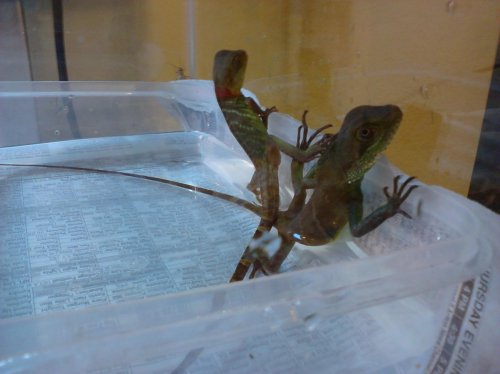hinoco1225
New Member
I took in three neglected juvenile Chinese water dragons last night. I've got them set up in a 20L, which I know is not big enough for them, but it's the best I can do right now. Two of them are very lethargic, so they're not doing any running around anyway. At least they have proper access to heat and UVB now. They had both bulbs before, but with the way the tank was set up, I don't think they got sufficient heat or UVB. I don't see any signs of MBD with any of them; only lethargy. Anyway, I just wanted to let you all know what I'm doing with them and see if anybody has any more tips that could help me nurse them back to health.
Since the tank is fairly small, all I have in there is a water dish (big enough for full-body soaking), a dish of greens (which they have shown zero interest in), and a large log hide. Basking light is above the hide and the temp is about 89 right now. I soaked them all individually and misted the habitat once this morning. I offered a few crickets dusted with plain calcium, but they didn't eat any of them. I got some ReptaBoost and got two of the dragons to take some of it just now. Other than that, I'm just watching them for any changes.
Is there anything else I can do? I really want these guys to make it.
Also, is it possible they could be stressing each other out? They are all still very young, and they have always been together. I haven't seen any fighting or anything, but I know that water dragons should live alone as they mature.
Since the tank is fairly small, all I have in there is a water dish (big enough for full-body soaking), a dish of greens (which they have shown zero interest in), and a large log hide. Basking light is above the hide and the temp is about 89 right now. I soaked them all individually and misted the habitat once this morning. I offered a few crickets dusted with plain calcium, but they didn't eat any of them. I got some ReptaBoost and got two of the dragons to take some of it just now. Other than that, I'm just watching them for any changes.
Is there anything else I can do? I really want these guys to make it.
Also, is it possible they could be stressing each other out? They are all still very young, and they have always been together. I haven't seen any fighting or anything, but I know that water dragons should live alone as they mature.





